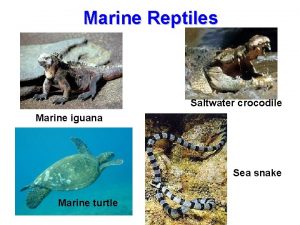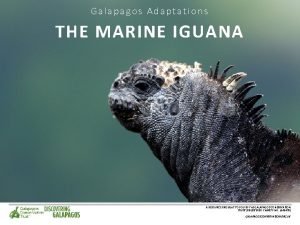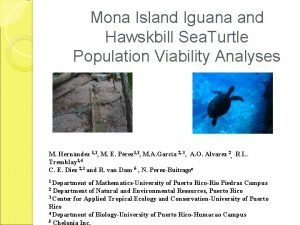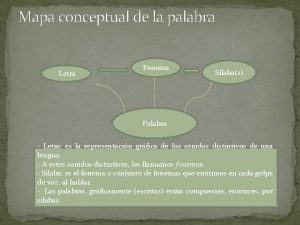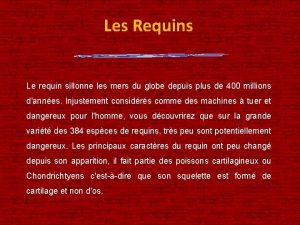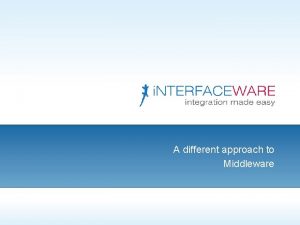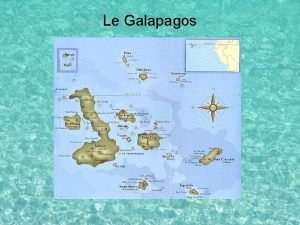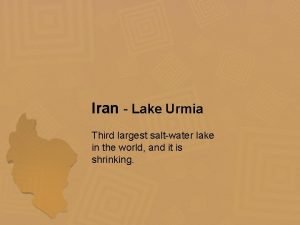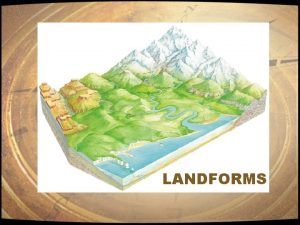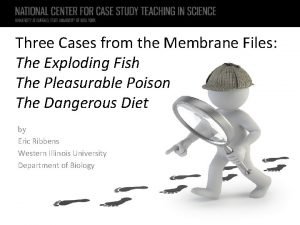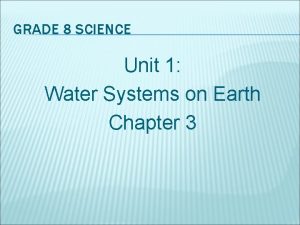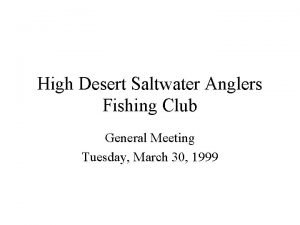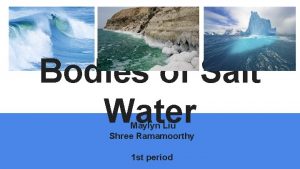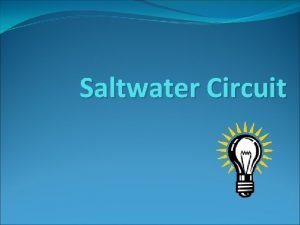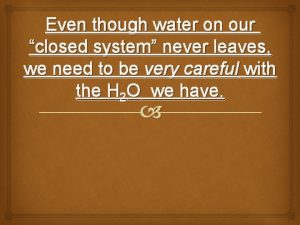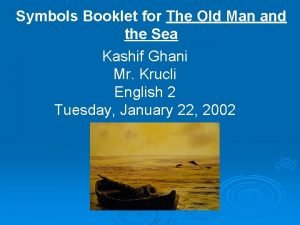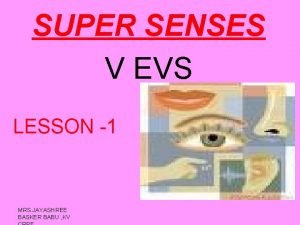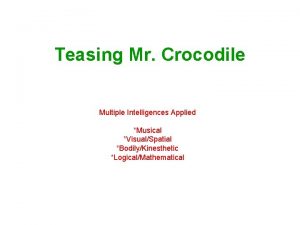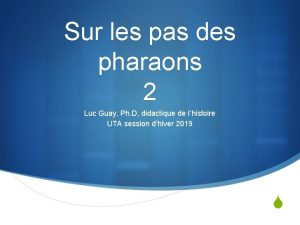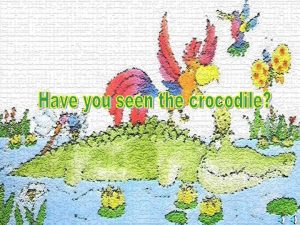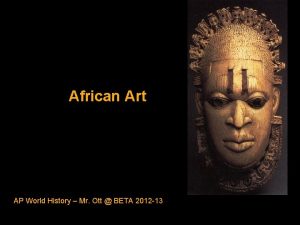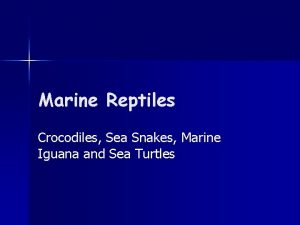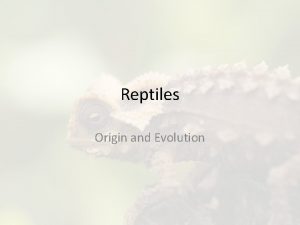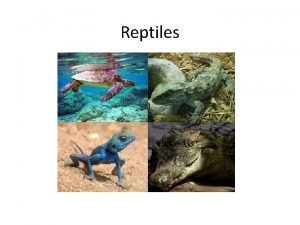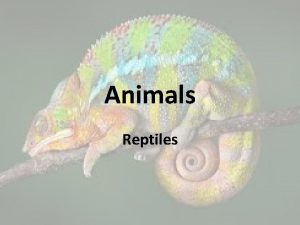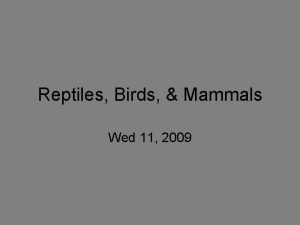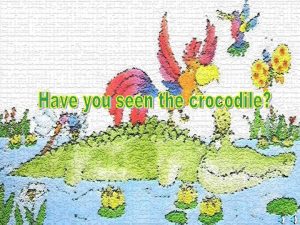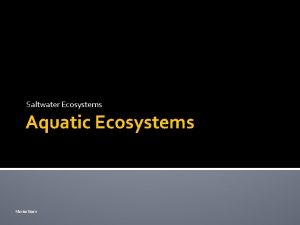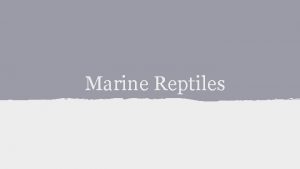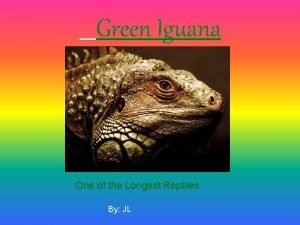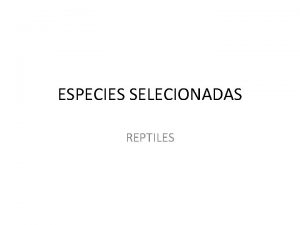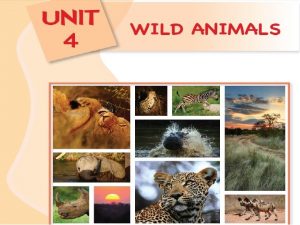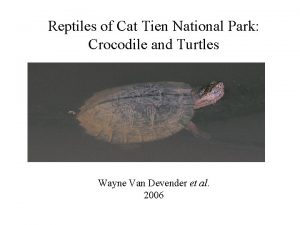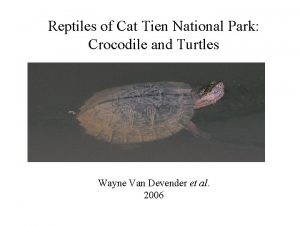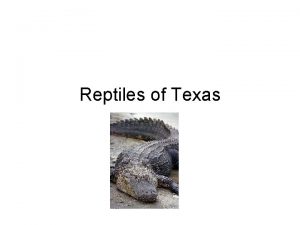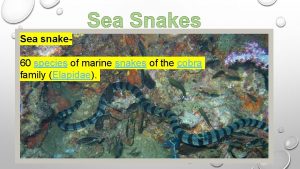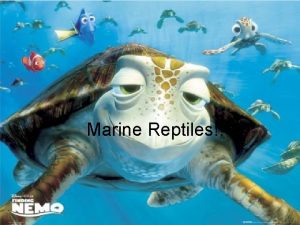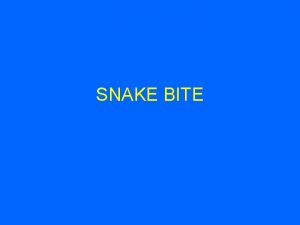Marine Reptiles Saltwater crocodile Marine iguana Sea snake


































- Slides: 34

Marine Reptiles Saltwater crocodile Marine iguana Sea snake Marine turtle

Sea Snakes Yellow- bellied sea snake

Diversity: • • Sea Snakes Laticodtidae- krates- 5 species (1 is fw in Solomon Islands) Hydrophidae- 54 different species All derived from Colubrid ancestor; colubrids evolved 40 mya; Laticotids evolved from colubrids 30 mya Location: • • Laticotids- live from east coast India to Japan and come to the tip of Cape York (Australia) Hydrophiids- found from south tip of Africa to India to South East Asian Islands to Japan to north half of Australia Habitat: • Primarily tropical; coastal estuaries, coral reefs, open sea; 33 -36 o. C

Sea Snakes • Behavior: Often schooling in aggregations; Not aggressive but human fatalities have occurred • Prey: Feed on small fish or squid, which are killed with powerful venom • Predators (few): sharks, snapper, grouper, crabs, saltwater crocodiles, raptors; they descend to escape • Venom: 2 -10 times as toxic as that of a cobras

Sea Snakes Adaptations to life in the sea 1. Osmoregulation: skin is impermeable to salts; salts eliminated by sublingual gland 2. Developing a flattened paddle-shaped tail and a laterally compressed body. 3. Reduced metabolic rate and increased tolerance for low oxygen levels 4. Lungs- greatly enlarged; hydrostatic organ 5. Gaseous exchange - lungs and the skin.

Reproduction: Sea Snakes • Krates are oviparous and lay eggs on land • Hydrophiids are viviparous and produce young in the water • Not much known about breeding • However, olive sea snake breed in spring; seasonal courtship displays Olive Sea Snake

Saltwater crocodiles • Largest living crocodilians: 6 -7 m long • Eggs laid and incubated on land • Tropical and subtropical

Marine Iguanas • • • Marine lizard endemic to Galapagos islands Herbivorous: graze on seaweeds Salt-glands on nose to eliminate excess salt Recently observed feeding on land for first time They return to land to escape predators.


Found in fossil record 200 mya (Triassic) Common in Cretaceous (130 mya) Present day genera originated 60 (Eocene) and 10 mya (Pleistocene) Not a very diverse group Mostly tropical and subtropical

Class Reptilia Order Chelonia- warm to temperate and boreal seas ex. leatherback, ridley's, kemps Order Chelonia. F. Cheloniidae- green, flatback, hawksbill, loggerhead F. Dermochelidae- leatherback reduced shell, dermal bone scutes compose shell F. Emydidae- diamond back terrapin Hawaii species- green, hawksbill, leatherback, Olive Ridley

Conservation Status 1. International Union for the Conservation of Nature (IUCN), also called the World Conservation Union 2. The Convention on International Trade in Endangered Species (CITES) 3. The United States Fish and Wildlife Service. 1. Endangered-facing a very high risk of extinction in the wild 2. Vulnerable -facing a high risk of extinction in the wild 3. Threatened-close to qualifying in one of the above categories

flatback Class: Reptilia: Reptiles Order: Chelonia: Turtles and Tortoises Family: Chelonidae: Marine Turtles Scientific Name: Natator depressus Diet: sea cucumbers, soft corals, jellyfish Size: < 1 m in length Conservation Status: vunerable Habitat: near continental shelf, shallow, soft bottom sea beds Range: northern part of Australia

Class: Reptilia: Reptiles Green turtle Order: Chelonia: Turtles and Tortoises Family: Chelonidae: Marine Turtles Scientific Name: Chelonia mydas Diet: seagrass and algae Size: ~500 lbs Conservation Status: threatened Habitat: high energy ocean beaches, convergence zones in the pelagic habitat, benthic feeding grounds in relatively protected waters Range: throughout world in all tropical and subtropical oceans

hawksbill Class: Reptilia: Reptiles Order: Chelonia: Turtles and Tortoises Family: Chelonidae: Marine Turtles Scientific Name: Eretmochelys imbricata Diet: Shellfish Size: 76 - 91 cm (30 - 36 in) Conservation Status: Endangered Habitat: coral reefs, rocky coasts Range: Tropical Atlantic, Pacific and Indian Oceans; Caribbean

Loggerhead Class: Reptilia: Reptiles Order: Chelonia: Turtles and Tortoises Family: Chelonidae: Marine Turtles Scientific Name: Caretta caretta Diet: Crustaceans Size: 76 - 102 cm (30 - 40 in) Conservation Status: Vulnerable Habitat: coasts, open sea Range: Temperate and tropical areas of the Pacific, Indian and Atlantic Oceans

leatherback Class: Reptilia: Reptiles Order: Chelonia: Turtles and Tortoises Family: Dermochelidae: Marine Turtles Scientific Name: Dermochelys coriacea Diet: sea jellies and salps Size: 1500 lbs Conservation Status: endangered Habitat: pelagic water Range: tropical seas, oceanic islands, Atlantic, Pacific, & Indian Ocean

• reduced shell, • dermal bone scutes compose shell • 7 dorsal and 5 ventral dermal bones

Physiology: Poikilothermic (cold blooded) Skin has scales Speed- 35 mph Breath holding- 2 hrs, when sleeping or resting Maturity- 10 -50 yrs for green Cannot retract heads like terrestrial turtles Lacrimal gland- salt secretion (drinks seawater)

Anatomy Has both internal and external skeleton- provided protection and support for organs Fused ribs Powerful sense of smell- find natal beach No ears, but can perceive low frequency sound and vibrations Male & female- difference in tail size; males tail extends past rear flippers, females is shorter

Mating- at sea Migration- occurs in late spring; female is accompanied by male Green sea turtles migrate as far as 800 miles from feeding area to nest in Northwestern Hawaiian Islands Egg laying behavior- return to same beach (natal beach)

Kemps Ridley nesting Usually nest at night Front flippers dig pit, rear flippers carve out burrow

Egg tooth- used to chip away at shell Group effort to get out of nest- emerge at night (safer) and head towards brightest light Artificial lights- confuse hatchlings Turtle nest Cross section

Leatherback hatching Kemps Ridley hatchlings Clutch size- about 100 eggs & covers pit with sand Egg incubation- 2 months depending upon species Sex determined by temperature- males lower temp, females higher temp


Sea grass and Algae- adult green sea turtle Epiphytes on sea grass, Sponges, fish, crabs, conch- loggerheads (suction feeders) Gelatinous zooplankton: siphonophores jellyfish Crustaceans, mollusks, echinoderms- Ridley

Eggs- skunks, raccoons, pigs, lizards, crabs, ants, beetles, fungal and bacterial infections Hatchlings- birds, mammals, crabs Adults- sharks, humans

Hawaii- 100 -350 nesting females French Frigate Shoals in the Northwest Hawaiian chain A. Hunters B. Fisheries C. Marine Debris D. Coastal Development and Habitat Degradation E. Fibropapilloma

• Meat • Eggs- nearly forbidden in all countries with nesting beaches • Soup • Jewelry • Leather Convention on International Trade in Endangered Species (CITES): turtle commerce prohibited in countries that signed agreement

Law enforcement- in Hawaii, turtles protected under Endangered Species Act Riding or harassing- $100, 000 fine + prison time Bringing turtle products into Hawaii- $20, 000 + prison time Fishing regulations- Shrimp Trawlers - incidental catch by commercial shrimp fish nets: drowned 10, 000 turtles each year Drift nets, gill nets Turtle Excluder Device (TED) Increase sea turtle populations: Ranching- eggs or hatchlings from wild populations Farming- originally from wild populations, for breeding stock

Catch Statistics (1987) FAO yearbook on Fishery Statistics 3100 metric tons Western Central Atlantic 1200 Eastern Central Pacific- 864 South East Pacific 305 Western Central Pacific 258 North West Pacific 190 Eastern Central Atlantic- 153 Eastern Indian Ocean- 50 Western Indian Ocean- 37 Mediterranean 20 South East Atlantic 10

Marine Debris- plastic bags, soda can plastic rings, fishing line, oil and tar Costal development and habitat degradation- noise, light, beach obstructions- affect nesting habitat

Fibropapilloma- virus in Green turtles Affects ability to feed, see, move about, or breath May be due to pollutants, blood parasites, or habitat change Kaneohe Bay (1991)- >50% infected

Turtle Excluder Device
 Marine reptiles
Marine reptiles Saltwater iguana
Saltwater iguana Adaptations of a marine iguana
Adaptations of a marine iguana Giant sea snake
Giant sea snake Komodo dragon names
Komodo dragon names Mapa conceptual de las silabas
Mapa conceptual de las silabas Common iguana
Common iguana Iguana middleware
Iguana middleware Cosa mangiano le iguane
Cosa mangiano le iguane Iguana cms
Iguana cms I wanna iguana persuasive writing
I wanna iguana persuasive writing Largest saltwater lake in the world
Largest saltwater lake in the world Is the hudson bay saltwater
Is the hudson bay saltwater Saltwater fish in freshwater explode
Saltwater fish in freshwater explode Saltwater round fish
Saltwater round fish Dissolving golf balls
Dissolving golf balls Mrs bader grade 8 science
Mrs bader grade 8 science High desert saltwater anglers
High desert saltwater anglers Salt water bodies
Salt water bodies Describe how the saltwater circuit works
Describe how the saltwater circuit works Pie chart of freshwater and saltwater
Pie chart of freshwater and saltwater Sea and marine otters belong to the order carnivora.
Sea and marine otters belong to the order carnivora. Jellyfish
Jellyfish Marlin symbolism
Marlin symbolism Troy aegean sea
Troy aegean sea Sea stack diagram
Sea stack diagram Yellow sea and east china sea
Yellow sea and east china sea Deer super senses
Deer super senses Ickle me pickle me tickle me too meaning
Ickle me pickle me tickle me too meaning Along came mr crocodile quiet as can be
Along came mr crocodile quiet as can be Crocodile on the loose poem by mrs prejna
Crocodile on the loose poem by mrs prejna Chapiteau campaniforme
Chapiteau campaniforme Crocodile plural
Crocodile plural Monolith with bird and crocodile
Monolith with bird and crocodile Crocodile technology
Crocodile technology
